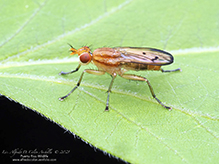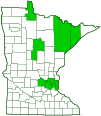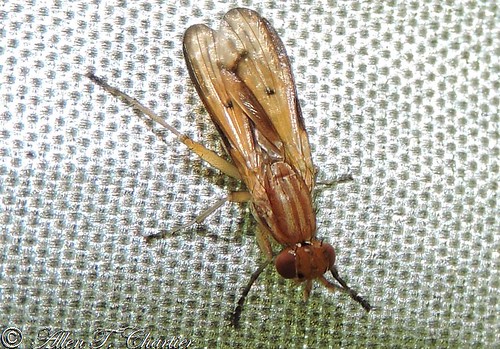marsh fly
(Tetanocera plebeja)
Conservation • Description • Habitat • Ecology • Distribution • Taxonomy
Conservation Status |
|
|||||||
| IUCN Red List | not listed |
|||||||
| NatureServe | NNR - Unranked |
|||||||
| Minnesota | not listed |
|||||||
Description |
||
Tetanocera plebeja is a common and sometimes abundant marsh fly. It is small for a fly but medium-sized for a marsh fly. It occurs in the United States from Maine to Pennsylvania, west to Minnesota and Iowa, and there are scattered records in the west. It also occurs in southern Canada from Nova Scotia to Winnipeg. Adults are found from late May to mid-September in marshy areas near ponds and streams. They are short lived and there are multiple generations per year. The larvae are aquatic. They are parasites of gray field slug and marsh slug. They eventually kill their hosts. Adults are ¼″ to 5⁄16″ (7.1 to 7.4 mm) in length and have a 5⁄16″ (7.6 mm) wing length. There are two large compound eyes on the side of the head and three small simple eyes (ocelli) in a triangle on top of the head. Two bristles rise from the ocellar triangle. A distinct longitudinal band (vitta) extends from the ocellar triangle to the front margin of the forehead (frons). The vitta is broad, polished, and almost parallel sided. It is not enlarged at the front. The antennae are orange, long (for a fly), and distinctly projected forward. They have three segments. The second segment does not have a longitudinal groove (suture). When viewed from above, it is at least half as long as the third segment. The third segment has a long, bristle-like extension (arista). The arista is black and feather-like (plumose) with long and very close black hairs. The front part of the body (mesonotum) is brownish-yellow with several longitudinal, brownish-orange stripes. On the upper side, there are two narrow stripes in the middle above (middorsal) and a bold stripe at each lateral margin. There is also a bold stripe on each side of the mesonotum. The plate between the abdomen and the thorax (scutellum) is the same color as the mesonotum and is not shiny. The abdomen is brownish-yellow, usually with a darker longitudinal stripe in the middle and another on each side. The wings are brownish-yellow. The entire leading edge (costal margin) beginning with the stigma is margined with blackish-brown, and that continues a little beyond the wingtip. There is a grayish streak in cell r4+5, and cell m usually has a dark cloud in the center. The cross vein (r-m) near the center of the wing is short and straight. The cross vein (dm-cu) near the wingtip is long and distinctly curved, but too steeply curved to be called an S-shape. Both cross veins are margined with brownish-black. When the wings are completely closed, the cross veins of both wings taken together appear, to this writer at least, like a smiley face. The legs are brownish-yellow. The fourth leg segment (tibia) is usually a little darker than the third segment (femur). On the middle legs, the femur has small stiff hairs (setulae) but no long bristle-like hairs (setae). On the hind legs, the fourth leg segment (tibia) has only one seta before the tip. The last part of the leg (tarsus), corresponding to the foot, has five segments. On the front legs, the first tarsal segment (basitarsus) is not paler than the basitarsus on the other legs. On all legs, the tarsi are blackened toward the tips. |
||
Size |
||
Total length:¼″ to 5⁄16″ (7.1 to 7.4 mm) |
||
Similar Species |
||
Habitat |
||
Marshy areas near ponds and streams |
||
Ecology |
||
Season |
||
Multiple generations per year: late May to mid-September |
||
Behavior |
||
|
||
Life Cycle |
||
Pupae overwinter in leaf litter. |
||
Larval Hosts |
||
Gray field slug (Deroceras reticulatum) and marsh slug (Deroceras laeve) |
||
Adult Food |
||
|
||
Distribution |
||||
|
Sources |
|||
| 9/4/2023 | ||||
Occurrence |
||||
|
||||
Taxonomy |
|||
Order |
Diptera (Flies) | ||
Suborder |
Brachycera | ||
Infraorder |
Cyclorrhapha | ||
| Zoosection | Schizophora | ||
| Zoosubsection | Acalyptratae (acalyptrate flies) | ||
Superfamily |
Sciomyzoidea (kelp, marsh, thick-headed flies, and allies) | ||
Family |
Sciomyzidae (marsh flies) | ||
Subfamily |
Sciomyzinae | ||
Tribe |
Tetanocerini | ||
Genus |
Tetanocera | ||
Synonyms |
|||
|
|||
Common Names |
|||
This species has no common name. The common name of the family Sciomyzidae is marsh flies, and it is applied here for convenience. |
|||
Glossary
Arista
A large bristle on the upper side of the third segment of the antenna of a fly. Plural: aristae.
Costal margin
The leading edge of the forewing of insects.
Femur
On insects and arachnids, the third, largest, most robust segment of the leg, coming immediately before the tibia. On humans, the thigh bone.
Frons
The upper front part of an insect’s face, roughly corresponding to the forehead.
Mesonotum
The principal exoskeletal plate on the upper (dorsal) part of the middle segment of the thorax of an insect.4
Scutellum
The exoskeletal plate covering the rearward (posterior) part of the middle segment of the thorax in some insects. In Coleoptera, Hemiptera, and Homoptera, the dorsal, often triangular plate behind the pronotum and between the bases of the front wings. In Diptera, the exoskeletal plate between the abdomen and the thorax.
Seta
A stiff, hair-like process on the outer surface of an organism. In Lepidoptera: A usually rigid bristle- or hair-like outgrowth used to sense touch. In mosses: The stalk supporting a spore-bearing capsule and supplying it with nutrients. Plural: setae. Adjective: setose.
Stigma
In plants, the portion of the female part of the flower that is receptive to pollen. In Lepidoptera, an area of specialized scent scales on the forewing of some skippers, hairstreaks, and moths. In other insects, a thickened, dark, or opaque cell on the leading edge of the wing.
Tibia
The fourth segment of an insect leg, after the femur and before the tarsus (foot). The fifth segment of a spider leg or palp. Plural: tibiae.
Visitor Photos |
|||||
Share your photo of this insect. |
|||||
| This button not working for you? Simply email us at info@MinnesotaSeasons.com. Attach one or more photos and, if you like, a caption. |
|||||
Alfredo Colon |
|||||
 |
|||||
MinnesotaSeasons.com Photos |
|||||
|
|||||

Visitor Videos |
|||
Share your video of this insect. |
|||
| This button not working for you? Simply email us at info@MinnesotaSeasons.com. Attach a video, a YouTube link, or a cloud storage link. |
|||
Other Videos |
|||


Created: 9/4/2023
Last Updated:





